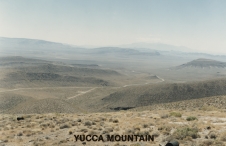Fantasy, Horror, and Science Fiction
Nevada's varied settings and history have provided fantasy, science fiction, and horror genres with two very different urban settings, snowy mountains, empty deserts, isolated towns, mining history, near-mythic characters, and, of course, gambling and prostitution.
Four novels utilize the landscape of Reno, Las Vegas, and the empty spaces in between. Susan Palwick's The Necessary Beggar (2006 Alex Award winner) is set in Reno and the nearby desert. Palwick, a Reno area resident, creates a tale of reconciliation, cultural differences, and displacement in post-9/11 America with a family exiled from their paradisiacal other-world and stranded in a near-future Nevada. The book's Reno chapters depict homelessness and the grind of working in a service-based economy. But the true Nevada element is the refugee camp located in the desert, where the desert renders citizens safe from the refugees and the refugees safe from rabidly anti-immigration citizens. Using the Nevada desert to both isolate and protect a problematic element is evocative of the proposed nuclear waste repository at Yucca Mountain in south-central Nevada.
Stephen King's Desperation (1996) takes place in a former mining town in central-eastern Nevada. Desperation, a town located off Highway 50, has succumbed to an ancient evil presence emanating from a recently reopened mine. Characters battling the evil—both townsfolk and travelers kidnapped off Highway 50—learn that the same evil was released and contained one hundred years before, in Desperation's boomtown days. King's novel uses several Nevada/desert tropes, including mining, Chinese labor, remote settlement, ghost towns, and "threatening" wildlife such as tarantulas, scorpions, and rattlesnakes. It was made into a 2006 TV movie starring Tom Skerritt and Ron Perlman.
Stephen King's The Stand (1978) uses Las Vegas as a key element. A post-pandemic, end-of-the-world story, the novel's final stand takes place on the Las Vegas Strip, the city to which selfish, greedy, or depraved survivors flock; they are led by an evil figure (the good survivors go to Boulder, Colorado). In the end, Las Vegas survivors are destroyed by a nuclear warhead brought to the city from the nearby Nevada Test Site. The novel was a 1994 TV miniseries starring Gary Sinise, Ossie Davis, and Rob Lowe.
The Las Vegas area, including Hoover Dam and Lake Mead, is the central setting for Tim Powers' Last Call, winner of the 1993 World Fantasy Award. Driving the desert highways between Las Vegas and Southern California, the characters engage in a struggle over who will become the next Fisher King, the symbol of health for the Western World. The choice will ultimately be made through a poker game played with a cursed Tarot deck. The story incorporates themes from the Fisher King/Grail myths and elements of T.S. Eliot's The Waste Land, as well as professional gambling, the mob-laced story of Las Vegas' development, and Bugsy Siegel's death.
Short speculative fiction also makes use of settings in Reno, Las Vegas, and the Sierra Nevada foothills. Spirits of Sage, Wind and Sun, by Reno area resident Jennifer Rachel Baumer (2003), moves between a south Reno neighborhood and American Flats, an abandoned mine and smelter near Virginia City. The story of a freelance photographer and her temporary relationship with an immigrant family who run the neighborhood store, Spirits especially shines in its powerful descriptions of the high-altitude desert. Palwick's Cucumber Gravy (2001), set north of Reno, manages to incorporate a wealth of Nevada/desert tropes—isolation and independence, distrust of the government, illicit drug production, gun culture, and space aliens—into a story of softened emotions and Christ-like hospitality, without a hint of farce. A second Palwick story, Going After Bobo (2000) takes place in north Reno and the Sierra Nevada foothills in the near future. Bobo, a pet cat, is given a GPS collar by his young master, a boy who has lost his father to suicide and who is trying desperately to hold on to the rest of his family. The boy's mother, a legal prostitute, must also wear a GPS marker by Nevada law governing the "ranch" (brothel) system. Despite the boy's care, Bobo disappears into the snowy mountains, leading to the story's climax.
Two short stories set in Las Vegas deal with redemption and despair. Ed Marsh's Dark Vegas (1997) depicts Las Vegas as a well of true evil, a force contained by the prayers of a single glassworker worked into its millions of neon tubes over the years. After his death, his apprentice is left with the task of taming Vegas' darkness lest it leach out over America. Fading Away (2007), a work of flash fiction by Jay Lake, is set on a single summer afternoon when a young boy whose mother is dying finds help from the ghost of Elvis Presley—"Vegas Elvis," fat and wearing a white rhinestone jumpsuit, but still able to wield the power of tender, heartfelt song.
Article Locations
Related Articles
Further Reading
None at this time.


